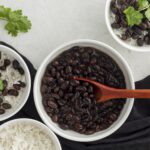South Africa is a country known for its rich culinary heritage, influenced by a diverse mix of cultures and traditions. One particular delicacy that has captured the hearts and palates of many South Africans is roosterbrood. Roosterbrood, which translates to “grilled bread” in English, is a type of bread that is traditionally baked over an open fire or braai (barbecue) and has become a beloved staple at South African gatherings and outdoor events.
The history of roosterbrood can be traced back to the nomadic lifestyle of the indigenous Khoikhoi and San people, who inhabited the southern regions of Africa for thousands of years. These tribes would bake bread by placing dough on the hot coals of a fire, creating a rustic and smoky flavor. Over time, as European settlers arrived in South Africa, their culinary techniques and ingredients melded with the local traditions, giving rise to the unique flavors of roosterbrood as we know them today.
The making of roosterbrood involves a simple yet time-honored process. The dough is typically made with flour, water, yeast, salt, and sometimes sugar, resulting in a soft and elastic texture. The dough is then shaped into round balls or flattened discs, allowing for even cooking on the grill. The bread is placed directly on the grid or skewered onto long, thin metal rods and cooked over an open flame. The heat creates a delicious crust on the outside while keeping the interior soft and fluffy.
What sets roosterbrood apart from regular bread is the distinct flavor imparted by the grilling process. The open fire adds a smoky essence to the bread, enhancing its natural taste and creating a unique aroma. The crust develops a beautiful charred appearance, adding a satisfying crunch to every bite. The combination of the smoky exterior and the soft, warm center makes roosterbrood a delightful treat to enjoy on its own or as an accompaniment to various dishes.
Roosterbrood is incredibly versatile and can be enjoyed in many ways. It can be served plain, allowing its smoky flavors to shine, or accompanied by butter, spreads, or dips. Some South Africans love to stuff their roosterbrood with fillings such as cheese, biltong (dried and cured meat), or boerewors (traditional South African sausage). The fillings melt into the warm bread, creating a burst of flavors and textures that tantalize the taste buds.
Roosterbrood has also become an integral part of the South African braai culture. Braaing is a beloved pastime in South Africa, akin to a social gathering centered around grilling and sharing food. Roosterbrood is often prepared alongside marinated meats, sosaties (kebabs), and other grilled delicacies. It brings people together, as they eagerly gather around the fire, eagerly waiting for the bread to be cooked to perfection.
In recent years, roosterbrood has gained popularity beyond South Africa’s borders. It is increasingly being featured in international food festivals and has even made appearances in restaurants worldwide. The rustic charm and unique flavors of roosterbrood have captivated food enthusiasts, who appreciate its simplicity and the connection it fosters with South Africa’s vibrant culinary heritage.
Whether you’re a South African reminiscing about the flavors of home or an adventurous food lover keen on exploring global cuisines, roosterbrood offers a taste experience that is truly unforgettable. Its history is steeped in tradition, and its flavors are a testament to the diverse influences that have shaped South African cuisine. So, the next time you have the opportunity to enjoy this delightful grilled bread, savor every bite and embrace the spirit of South Africa’s roosterbrood culture.








